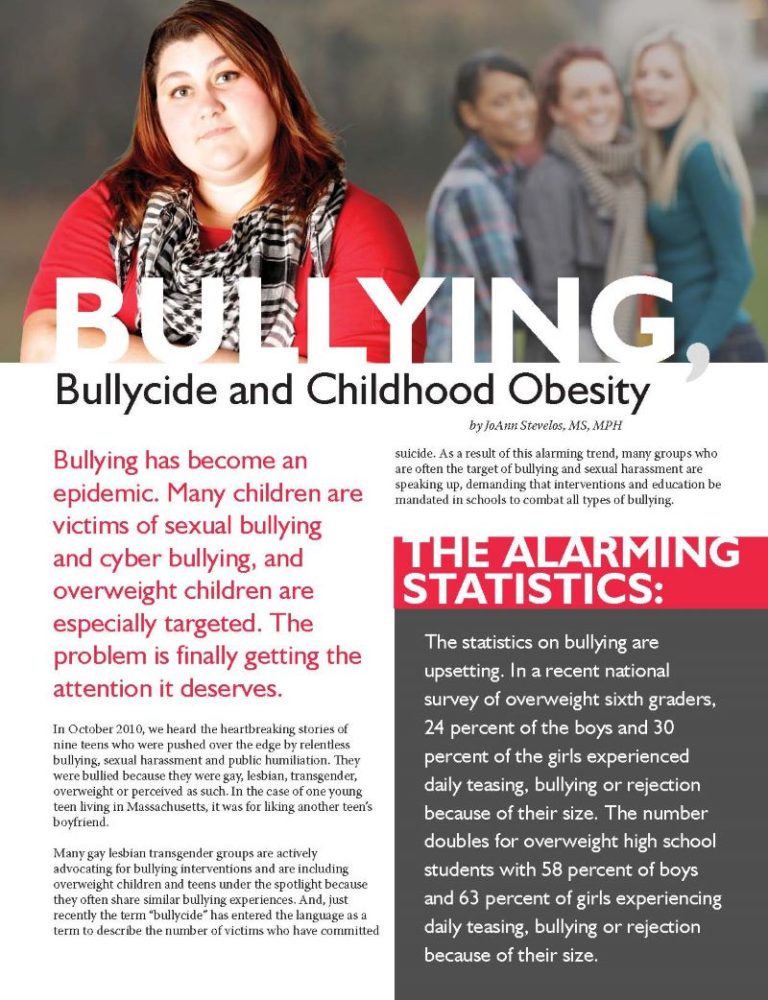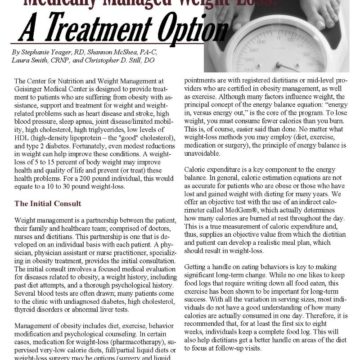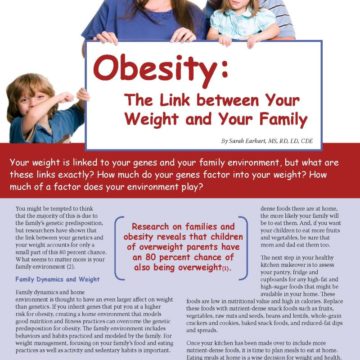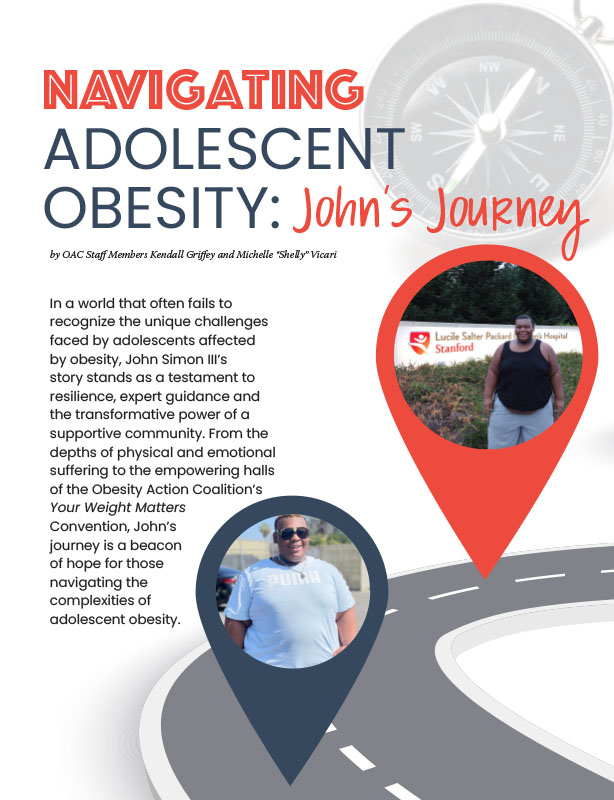BULLYING, Bullycide and Childhood Obesity


by JoAnn Stevelos, MS, MPH
Winter 2011
Bullying has become an epidemic. Many children are victims of sexual bullying and cyberbullying, and overweight children are especially targeted. The problem is finally getting the attention it deserves.
In October 2010, we heard the heartbreaking stories of nine teens who were pushed over the edge by relentless bullying, sexual harassment and public humiliation. They were bullied because they were part of the LGBTQ+ community, overweight or perceived as such. In the case of one young teen living in Massachusetts, it was for liking another teen’s boyfriend.
Many LGBTQ+ groups are actively advocating for bullying interventions and are including overweight children and teens under the spotlight because they often share similar bullying experiences. And, just recently the term “bullycide” has entered the language as a term to describe the number of victims who have committed suicide. As a result of this alarming trend, many groups who are often the target of bullying and sexual harassment are speaking up, demanding that interventions and education be mandated in schools to combat all types of bullying.
The Alarming Statistics:
The statistics on bullying are upsetting. In a recent national survey of overweight sixth-graders, 24 percent of the boys and 30 percent of the girls experienced daily teasing, bullying or rejection because of their size. The number doubles for overweight high school students with 58 percent of boys and 63 percent of girls experiencing daily teasing, bullying or rejection because of their size.
In 2009, Oprah Winfrey announced the beginning of a national conversation to stop bullying in schools. A national campaign to stop bullying began in 2010 with the declaration of October as “National Bullying Prevention Month.” Yet, reports of child and teen deaths related to bullying continue.
What is bullying?
The U.S. Department of Education’s resources on bullying warn that too many organizations are creating their own definitions of bullying. After a thorough review, they found that nearly all of the definitions incorporate four key concepts:
- Bullying involves intentional, and largely unprovoked, efforts to harm another
- Bullying can be physical or verbal, and direct or indirect in nature
- Bullying involves repeated negative actions by one or more against another
- Bullying involves an imbalance of physical or psychological power
While it feels somewhat clinical and removed to define bullying in this manner, we must do so to address the issue in a consistent and effective manner. However, we must also talk about this issue in plain English to keep it real and to understand the impact of bullying.
Overweight children and teens who are bullied are often called names, punched, teased, ganged up on, humiliated and ignored relentlessly either in-person or in social media by mean and often troubled peers. Victims often feel depressed, sad, lonely, alienated, ostracized, angry, powerless, anxious and fearful. It is imperative that we address bullying in our schools, neighborhoods and communities because every child has the basic human right to feel safe and secure.
Who are the bullies and who are the victims?
A 2004 study of bullying behaviors in 5,749 boys and girls (11-16 years old) showed that overweight school-aged children were more likely to be the victims and perpetrators of bullying behaviors than their normal-weight peers. Furthermore, there are gender differences in bullying behaviors. Typically, both male and female children and teens report bullies making fun of the way they look, dress or talk. However, males are more likely to report being physically harmed through punching or kicking, whereas girls are more likely to be excluded, ostracized and the target of rumors, especially pertaining to sexual activity.
Another study attempted to understand if overweight children from different socio-economic classes were more vulnerable to bullying than others. Did it make a difference if the overweight child was male, female, black, white or Hispanic? Or, if they were rich or poor? Had good grades or poor grades? According to the lead researcher of the study, Dr. Julie C. Lumeng, “the child with obesity was simply more likely to be bullied than the child who was not; none of these things affected it at all.”
In fact, it comes as no surprise that overweight children are at risk for bullying. The risk factors associated with bullying victims – feelings of insecurity, low self-esteem, depression, social isolation and marginalization, lack of social skills and the inability to defend themselves in confrontational situations – are similar to the psycho-social conditions of overweight children and teens; depression, anxiety, social isolation and marginalization and low self-esteem.
What are the types of bullying?
There are different kinds of bullying according to Olweus, a Bully Prevention Program Web site:
- Verbal bullying
- Social exclusion or isolation
- Physical bullying
- Bullying through lies and false rumors
- Having money or other things taken or damaged
- Being threatened or forced to do things
- Racial bullying
- Sexual bullying
- Cyberbullying (via cell phone or the Internet)
Olweus also divides bullying into two forms: direct and indirect. Direct bullying usually involves confrontations, calling names, derogatory comments, hitting, kicking, shoving and chasing. Indirect bullying is equally aggressive, but partially hidden from the victim and can include social isolation, the spreading of lies and rumors to peers and ignoring victims in group activities. Cyberbullying may also fall into this category because the harassment and bullying is a step removed from face-to-face contact using text messaging or social media networks such as Facebook and YouTube.
What are the consequences of bullying?
Bullying is a highly individualized experience just as physical pain is. Some days the child or teen may weather bullying better than others. The type of bullying, the level, intensity and frequency of contact with the bully or bullies must be considered when assessing and evaluating the emotional and physical consequences of being a victim.
In general, children and teens who are bullied may tend to avoid school or playgrounds, thereby decreasing the quality of their educational and recreational experiences. As we have seen in recent news reports, children and teens who are victims of bullying may have thoughts of suicide and some actually commit suicide. However, again, we must be cautious when discussing the consequences of bullying in general terms because the threshold for different types of bullying will vary from child to child.
What can I do to help a child or teen who is being bullied?
Get educated. Effectively addressing bullying with your children will require rigor, humility, compassion and most importantly, listening to their experiences without judging them. This is difficult because it can be tempting to blame the child. You might want to say, “You need to learn to stick up for yourself.” Or you may be overprotective, as in, “I am calling her parents immediately.” These traps should be avoided because they will put you into a “camp” and harden your position, thus turning the situation into “us against them.” And to be honest, some days that will be the easiest way to deal with it. But, your best plan of action is to show your child how to use all the resources available to create a safer more secure environment for him or her.
Fully engaging your community will take time and determination. Schedule meetings with your school principal, guidance counselors and school bus drivers to review the school’s policies on bullying and harassment. If the school does not have a policy, ask if you can work with the school district or your state education department to form a task force to address bullying. Call the below listed national, state and local anti-bullying groups.
Surround your child with family and neighbors who know your child is being bullied and ask that they support you in protecting your child. Cultivating a “zero tolerance” for bullying environment in your child’s community ensures all children have access to a safe, nurturing, learning environment. You and your child can work together to ensure all kids are safe and empowered to speak up against bullies. Remember, you may be the only person your child can trust and come to for help.
Helping to Combat Bullying: Helpful Tips and Resources
If your child or teen is a victim of bullying, here are just a few things you can do to help. There are many more ideas and interventions to be found in the below-listed resources.
- Access the many resources available on the Internet. Below, you will find an extensive list of resources and organizations to help you help keep your child or teen safe.
- The most important thing is to help your child stay safe and to try to not escalate the situation.
- Help your child learn to defend themselves from bullies by encouraging them to stay calm, look the bully in the eye and stand up tall.
- Encourage your child to ask the adults around them for help.
- Make an appointment with your school principal and your child’s teacher to inform them of the bullying and to ask their help in addressing the situation. Ask about the school policies on bullying and for any available resources to help you and your child.
- When bullying incidents occur, write them down with your child. Keeping track of the incidents will help you prepare for meetings with teachers, parents and, if necessary, law enforcement officers.
- Encourage your child to join an organization or group at school. Be sure to create a safe and welcoming place for your child to have friends visit.
- Enrolling children in self-defense or martial arts classes can build their confidence and teach them how to protect themselves from bullies.
Resources
If you have friends or family members who have excess weight or obesity, please make time to watch three short and informative videos on weight prejudice and weight bias at the Yale Rudd Center for Food Policy and Obesity’s Web site. Share these videos with your local school district, PTA, local organizations, family and friends.
To view the videos, please visit the “Weight Bias & Stigma” section under “What We Do” on the Rudd Center Web site at www.yaleruddcenter.org.
For more information on bullying, please visit the following Web sites:
- Education.com
www.education.com/topic/school-bullying-teasing - National Institute of Health
www.nih.gov/news/health/sep2010/nichd-21.htm - Centers for Disease Control
www.cdc.gov/ncipc/dvp/electronic_aggression.htm
Center on Media and Child Health
Here is a resource and descriptions that are posted on Center on Media and Child Health Web site about bullying interventions and preventions programs:
- The Olweus Bullying Prevention Program (Center for the Study and Prevention of Violence). This program is a universal intervention for the reduction and prevention of bully/victim problems. The main arena for the program is the school, and school staff has the primary responsibility for the introduction and implementation of the program.
Cyberbullying Resources
- Cyberbullying 2010: What the Research Tells Us by Pew Internet & American Life Project – An updated look at the research and definitions around bullying and cyberbullying
- Electronic Media and Youth Violence: A CDC Issue Brief for Educators and Caregivers (2008) This document was developed for educators and caregivers and summarizes what is known about young people and electronic aggression and discusses the implications of these findings for school staff, educational policy makers, and caregivers.
- i-SAFE – This nonprofit foundation is dedicated to protecting the online experiences of youth everywhere. i-SAFE incorporates classroom curriculum with dynamic community outreach to empower students, teachers, parents, law enforcement, and concerned adults to make the Internet a safer place.
- IkeepSafe.org – This organization offers a variety of tools and resources for kids, parents and educators to empower them to teach children the safe and healthy use of technology and the Internet. Its educational resources teach children of all ages in a fun, age-appropriate way, the basic rules of Internet safety, ethics, and the healthy use of connected technologies.
How can communities help children and teens who are being bullied?
The most effective interventions are those that commit to both the prevention and treatment of bullying as a school-wide or organization-wide effort. Because of the increased awareness about bullying, there are many resources and programs available to help schools, parents and organizations create safe, secure environments for all children.
One study has determined that an effective program will address the roles of everyone associated with the school or organization and what they can do to stop bullying. Everyone from teachers and students to the principal, janitor, lunchroom worker and bus driver must feel empowered and compelled to enforce clear rules and become role models against bullying.
Conclusion
Dan Savage, an author and journalist who writes the internationally syndicated column, Savage Love, is leading a grassroots effort called, “It Gets Better.” The campaign is specifically aimed at gay and lesbian youth to let them know that despite their painful experiences and the depression that comes from being bullied, “it gets better” when you leave high school. Our overweight children and teens need to hear the same message, “it gets better.” They need us to step up and advocate for their basic human right to safe, secure environments where they can grow and thrive. We need to work together to make it better for them.
About the Author:
JoAnn Stevelos, MS, MPH, is a public health professional and consultant. Ms. Stevelos is the former director of the New York State funded Center for Best Practices for the Prevention of Early Childhood Obesity. She is currently the Chief Operating Officer for Verdade Consulting Group Inc., a small firm specializing in medical research ethics, bioethics, public health and health law. Ms. Stevelos is a member of the OAC Advisory Board.
References:
Department of Community Health and Epidemiology, Queen’s University, Kingston, Ontario, Canada. janssen@post.queensu.ca Accessed November 16, 2010.
Eaton DK, Lowry R, Brener ND, Galuska DA, Crosby AE. Associations of body mass index and perceived weight with suicide ideation and suicide attempts among US high school students. Arch Pediatr Adolesc Med. 2005 Jun;159(6):513-9.
Janssen I, Craig WM, Boyce WF, Pickett W. Associations between overweight and obesity with bullying behaviors in school-aged children. Pediatrics. 2004;113(5):1187-1194. Accessed: November 2010.
Lumeng JC, Forrest P, Appugliese DP, Kaciroti N, Corwyn RF, and Bradley RH. Weight Status as a Predictor of Being Bullied in Third Through Sixth Grades Pediatrics.2010; 0: 200907741-20090774.
Nansel, T.R., Overpeck, M., Pilla, R.S., Ruan, W.J., Simons-Morton, B., & Scheidt, P. Bullying Behaviors Among US Youth: Prevalence and Association With Psychosocial Adjustment., 285(16), 2094- 2100. 2001.
Olweus, D. Bullying at School: What We Know and What We Can Do. Cambridge, MA: Blackwell Publishers, Inc., p. 19. 1993.
Olweus Bully Prevention Program website: https://www.olweus.org/public/index.page.
Accessed November 2010.
Rigby, K. Health consequences of bullying and its prevention in schools. In J. Juvonen & S. Graham, Eds., Peer Harassment in School: The Plight of the Vulnerable and Victimized. New York: Guilford Press. 2001.
Ross, D. Childhood Bullying, Teasing, and Violence: What School Personnel, Other Professionals, and Parents Can Do (2nd ed.), p. 23. Alexandria, VA: American Counseling Association. 2003.
US Department of Education. Exploring the Nature and Prevention of Bullying. http//www2.ed.gov/admins/lead/safety/training/bullying/bullyingpg3.html#what. Accessed November 2010.
Vemberg EM and Biggs BK. Perspectives on Preventing and Treating Bullying. Chapter Two by Dempsey AG and Storch EA,
Psychopathology and Health Problems Affecting Involvement in Bullying.Oxford University Press. 2010
by Michelle “Shelly” Vicari Winter 2024 Winter has arrived! Don’t allow the chilly and damp weather to…
Read Articleby Kendall Griffey, OAC Communications Coordinator Winter 2024 The Obesity Action Coalition’s 12th annual Your Weight Matters…
Read Articleby OAC Staff Members Kendall Griffey and Michelle “Shelly” Vicari Winter 2024 In a world that often…
Read Article








